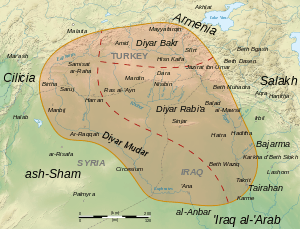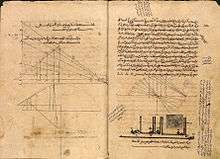Thābit ibn Qurra
Al-Ṣābiʾ Thābit ibn Qurrah al-Ḥarrānī (Arabic: ثابت بن قره, Latin: Thebit/Thebith/Tebit;[2] 826 or 836[3][4] – February 18, 901) was an Arab[5][6] Sabian mathematician, physician, astronomer, and translator who lived in Baghdad in the second half of the ninth century during the time of the Abbasid Caliphate.
Thābit ibn Qurra | |
|---|---|
| Born | 210-211 AH/ 826 or 836 AD |
| Died | Wednesday, 26 Safar, 288 AH / February 18, 901 AD |
| Academic background | |
| Influences | Banu Musa, Archimedes, Apollonius, Nicomachus, Euclid |
| Academic work | |
| Era | Islamic Golden Age |
| Main interests | Mathematics, Mechanics, Astronomy, Astrology, Translation, Number theory |
| Notable ideas |
|
| Influenced | Al-Khazini, Al-Isfizari, Na'im ibn Musa[1] |
Thābit ibn Qurrah made important discoveries in algebra, geometry, and astronomy. In astronomy, Thābit is considered one of the first reformers of the Ptolemaic system, and in mechanics he was a founder of statics.[4]
Biography

Thābit was born in Harran in Upper Mesopotamia, which at the time was part of the Diyar Mudar subdivision of the al-Jazira region of the Abbasid Caliphate. The city of Harran was never fully Christianized. By the early Muslim conquests, the people of Harran were still adhering to the cult of Sin.
Thābit and his pupils lived in the midst of the most intellectually vibrant, and probably the largest, city of the time, Baghdad. He occupied himself with mathematics, astronomy, astrology, magic, mechanics, medicine, and philosophy. Later in his life, Thābit's patron was the Abbasid Caliph al-Mu'tadid (reigned 892–902). Thābit became the Caliph's personal friend and courtier. Thābit died in Baghdad.
Translation

Thābit's native language was Syriac,[7] which was the eastern Aramaic variety from Edessa, and he was fluent in both Greek and Arabic.
Thābit translated from Greek into Arabic works by Apollonius of Perga, Archimedes, Euclid and Ptolemy. He revised the translation of Euclid's Elements of Hunayn ibn Ishaq. He also rewrote Hunayn's translation of Ptolemy's Almagest and translated Ptolemy's Geography. Thābit's translation of a work by Archimedes which gave a construction of a regular heptagon was discovered in the 20th century, the original having been lost.
Astronomy
The medieval astronomical theory of the trepidation of the equinoxes is often attributed to Thābit. But it had already been described by Theon of Alexandria in his comments of the Handy Tables of Ptolemy. According to Copernicus, Thābit determined the length of the sidereal year as 365 days, 6 hours, 9 minutes and 12 seconds (an error of 2 seconds). Copernicus based his claim on the Latin text attributed to Thābit. Thābit published his observations of the Sun.
Mathematics
In mathematics, Thābit discovered an equation for determining amicable numbers. He also wrote on the theory of numbers, and extended their use to describe the ratios between geometrical quantities, a step which the Greeks did not take.
He is known for having calculated the solution to a chessboard problem involving an exponential series.[8]
He computed the volume of the paraboloid.[9]
He also described a generalization of Pythagoras' theorem.[10]
Physics
In physics, Thābit rejected the Peripatetic and Aristotelian notions of a "natural place" for each element. He instead proposed a theory of motion in which both the upward and downward motions are caused by weight, and that the order of the universe is a result of two competing attractions (jadhb): one of these being "between the sublunar and celestial elements", and the other being "between all parts of each element separately".[11] and in mechanics he was a founder of statics.[4]
Works
Only a few of Thābit's works are preserved in their original form.
Eponyms
References
- Panza, Marco (2008). "The Role of Algebraic Inferences in Na'īm Ibn Mūsā's Collection of Geometrical Propositions". Arabic Sciences and Philosophy. 18 (2): 165–191. CiteSeerX 10.1.1.491.4854. doi:10.1017/S0957423908000532.
- Latham, J. D. (2003). "Review of Richard Lorch's 'Thabit ibn Qurran: On the Sector-Figure and Related Texts'". Journal of Semitic Studies. 48 (2): 401–403. doi:10.1093/jss/48.2.401.
- Roshdi Rashed (2009). "Thābit ibn Qurra. Science and Philosophy in Ninth-Century Baghdad. pp. 23–24.
- Holme, Audun (2010). Geometry : our cultural heritage (2nd ed.). Heidelberg: Springer. p. 188. ISBN 978-3-642-14440-0.
- "Thābit ibn Qurrah | Arab mathematician, physician, and philosopher". Encyclopedia Britannica.
- editors, general; Lindberg, David C.; Numbers, Ronald L. (2001). The Cambridge history of science (1. publ. ed.). Cambridge, U.K.: Cambridge University Press. p. 447. ISBN 978-0-521-59448-6.CS1 maint: extra text: authors list (link)
- "Thabit biography". www-groups.dcs.st-and.ac.uk.
The sect, with strong Greek connections, had in earlier times adopted Greek culture, and it was common for members to speak Greek although after the conquest of the Sabians by Islam, they became Arabic speakers. There was another language spoken in southeastern Turkey, namely Syriac, which was based on the East Aramaic dialect of Edessa. This language was Thābit ibn Qurra's native language, but he was fluent in both Greek and Arabic.
- Masood, Ehsad (2009). Science and Islam A History. Icon Books Ltd. pp. 48–49.
- Smith, David Eugen (1925). History of Mathematics, Volume II. p. 685.
- Aydin Sayili (Mar 1960). "Thâbit ibn Qurra's Generalization of the Pythagorean Theorem". Isis. 51 (1): 35–37. doi:10.1086/348837. JSTOR 227603.
- Mohammed Abattouy (2001). "Greek Mechanics in Arabic Context: Thabit ibn Qurra, al-Isfizarı and the Arabic Traditions of Aristotelian and Euclidean Mechanics", Science in Context 14, p. 205-206. Cambridge University Press.
- Van Brummelen, Glen (2010-01-26). "Review of "On the Sector-Figure and Related Texts"". MAA Reviews. Retrieved 2017-05-12.
Further reading
- Roshdi Rashed (ed.), Thābit ibn Qurra. Science and Philosophy in Ninth-Century Baghdad, Berlin, Walter de Gruyter, 2009.
- Francis J. Carmody: The astronomical works of Thābit b. Qurra. 262 pp. Berkeley and Los Angeles: University of California Press, 1960.
- Rashed, Roshdi (1996). Les Mathématiques Infinitésimales du IXe au XIe Siècle 1: Fondateurs et commentateurs: Banū Mūsā, Ibn Qurra, Ibn Sīnān, al-Khāzin, al-Qūhī, Ibn al-Samḥ, Ibn Hūd. London. Reviews: Seyyed Hossein Nasr (1998) in Isis 89 (1) pp. 112-113; Charles Burnett (1998) in Bulletin of the School of Oriental and African Studies, University of London 61 (2) p. 406.
- Churton, Tobias. The Golden Builders: Alchemists, Rosicrucians, and the First Freemasons. Barnes and Noble Publishing, 2006.
- Hakim S Ayub Ali. Zakhira-i Thābit ibn Qurra (preface by Hakim Syed Zillur Rahman), Aligarh, India, 1987.
External links
- Palmeri, JoAnn (2007). "Thābit ibn Qurra". In Thomas Hockey; et al. (eds.). The Biographical Encyclopedia of Astronomers. New York: Springer. pp. 1129–30. ISBN 978-0-387-31022-0. (PDF version)
- O'Connor, John J.; Robertson, Edmund F., "Al-Sabi Thabit ibn Qurra al-Harrani", MacTutor History of Mathematics archive, University of St Andrews.
- Rosenfeld, B. A.; Grigorian, A. T. (2008) [1970-80]. "Thābit Ibn Qurra, Al-Ṣābiʾ Al-Ḥarrānī". Complete Dictionary of Scientific Biography. Encyclopedia.com.
- Thabit ibn Qurra on Astrology & Magic
